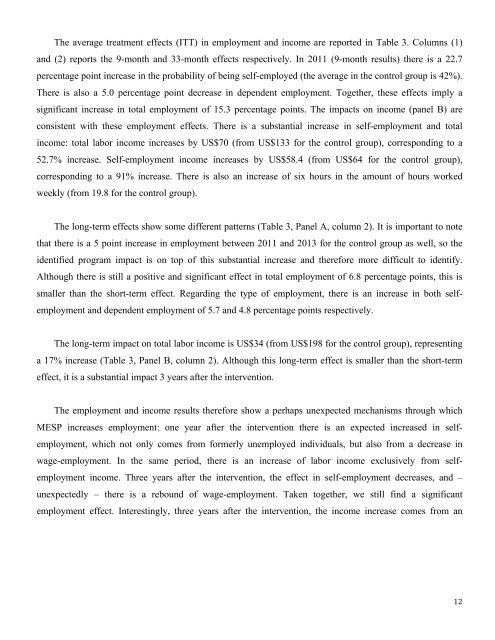DOCUMENTO
n?u=RePEc:ioe:doctra:461&r=lam
n?u=RePEc:ioe:doctra:461&r=lam
You also want an ePaper? Increase the reach of your titles
YUMPU automatically turns print PDFs into web optimized ePapers that Google loves.
The average treatment effects (ITT) in employment and income are reported in Table 3. Columns (1)<br />
and (2) reports the 9-month and 33-month effects respectively. In 2011 (9-month results) there is a 22.7<br />
percentage point increase in the probability of being self-employed (the average in the control group is 42%).<br />
There is also a 5.0 percentage point decrease in dependent employment. Together, these effects imply a<br />
significant increase in total employment of 15.3 percentage points. The impacts on income (panel B) are<br />
consistent with these employment effects. There is a substantial increase in self-employment and total<br />
income: total labor income increases by US$70 (from US$133 for the control group), corresponding to a<br />
52.7% increase. Self-employment income increases by US$58.4 (from US$64 for the control group),<br />
corresponding to a 91% increase. There is also an increase of six hours in the amount of hours worked<br />
weekly (from 19.8 for the control group).<br />
The long-term effects show some different patterns (Table 3, Panel A, column 2). It is important to note<br />
that there is a 5 point increase in employment between 2011 and 2013 for the control group as well, so the<br />
identified program impact is on top of this substantial increase and therefore more difficult to identify.<br />
Although there is still a positive and significant effect in total employment of 6.8 percentage points, this is<br />
smaller than the short-term effect. Regarding the type of employment, there is an increase in both selfemployment<br />
and dependent employment of 5.7 and 4.8 percentage points respectively.<br />
The long-term impact on total labor income is US$34 (from US$198 for the control group), representing<br />
a 17% increase (Table 3, Panel B, column 2). Although this long-term effect is smaller than the short-term<br />
effect, it is a substantial impact 3 years after the intervention.<br />
The employment and income results therefore show a perhaps unexpected mechanisms through which<br />
MESP increases employment: one year after the intervention there is an expected increased in selfemployment,<br />
which not only comes from formerly unemployed individuals, but also from a decrease in<br />
wage-employment. In the same period, there is an increase of labor income exclusively from selfemployment<br />
income. Three years after the intervention, the effect in self-employment decreases, and –<br />
unexpectedly – there is a rebound of wage-employment. Taken together, we still find a significant<br />
employment effect. Interestingly, three years after the intervention, the income increase comes from an<br />
12



